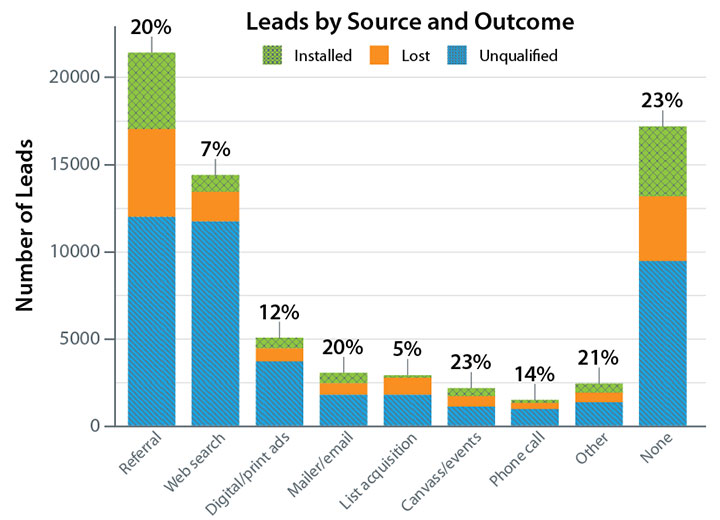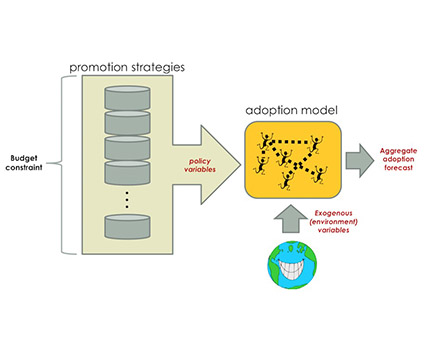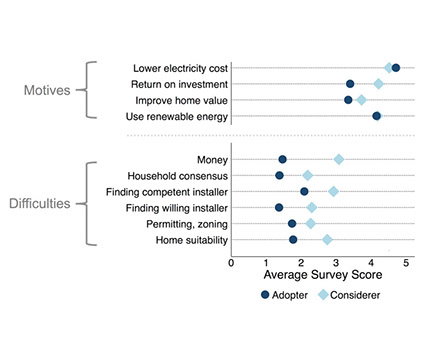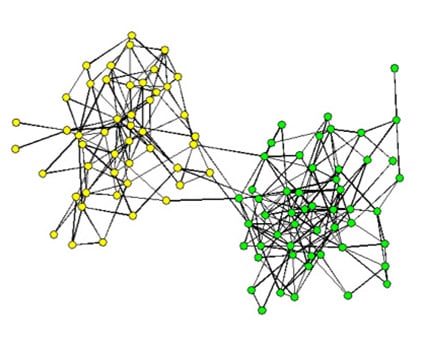Solar Energy Evolution and Diffusion Studies Webinars
These webinars provide information about NLR's work on the U.S. Department of Energy's Solar Energy Evolution and Diffusion Studies (SEEDS) program.
SEEDS 2017–2019 Study Webinars
The Solar Influencer Next Door: Predicting Low-Income Solar Referrals and Leads
Dec. 22, 2021
Presenter:
Ben Sigrin, NLR

This webinar describes methodology and results from an NLR study on the biggest source of solar referrals and leads in low-to-moderate income communities. NLR used California data and predictive models to determine the likelihood of solar referral and adoption among low- to moderate-income households—generally defined as a family of four making less than 80% of the median family income for their area. As modeled, referrals from friends are the biggest source of solar installations in disadvantaged communities. Conversely, intricate eligibility requirements for solar programs are the largest source of lost leads.
Watch the LMI solar referrals and leads presentation.
Download the LMI solar referrals and leads presentation slides.
Read the LMI solar referrals and leads report.
Two Studies Offer New Insights into Low-Moderate Income Solar Adoption
June 11, 2020
Presenters:
Ben Sigrin, NLR
Kim Wolske, University of Chicago
Tony Reames, University of Michigan
This webinar presented two new data-driven studies examining solar adoption by low-to-moderate (LMI) households, a much-discussed but less-studied area. These studies, funded by the SEEDS program, use data-driven methods to identify characteristics, motivations, and barriers to solar adoption in LMI communities.
Watch the LMI solar adoption presentation.
May 1, 2018
Presenters:
Ben Sigrin, NLR
Meghan Mooney, NLR

The report breaks down the total potential for solar energy production on the roofs of low-to moderate-income households by county.
The NLR report Rooftop Solar Technical Potential for Low-to-Moderate Income Households in the United States shows that nearly half of all residential rooftop solar potential in the U.S. is on the dwellings of LMI households, representing 320 gigawatts of total solar potential. In this webinar, the study's authors, Ben Sigrin and Meghan Mooney, discuss the report's findings and how they can help regulators, project developers, advocacy groups, and policymakers in states across the U.S. understand the true size of the market potential and where to best direct their resources.
Download the rooftop solar technical potential in LMI households presentation.
Download the rooftop solar technical potential in LMI households transcript.
Download the rooftop solar technical potential in LMI households video.
Using Machine Learning and Data Analysis To Improve Customer Acquisition and Marketing in Residential Solar
July 20, 2017
Presenters:
Kiran Lakkaraju, Sandia National Laboratories
Yevgeniy Vorobeychik, Vanderbilt University
Michael Rossol, NLR

Computer models, educated by existing solar adoption data, can help predict future trends in solar adoption.
High customer acquisition costs remain a persistent challenge in the U.S. residential solar industry. Effective customer acquisition in the residential solar market involves multiple moving parts: increasing referral rates, having a good ground game, and designing effective marketing campaigns. This webinar presented new research by NLR, Sandia National Laboratories, and Vanderbilt University on how data analytics, machine learning, and social science can improve residential solar marketing and customer acquisition processes.
Download the customer acquisition and marketing in residential solar presentation.
Download the customer acquisition and marketing in residential solar transcript.
Download the customer acquisition and marketing in residential solar fact sheet.
SEEDS 2014–2016 Study Webinars
Solar Aspirations and Disinclinations: Learning from 3,600 Households
June 29, 2016
Presenters:
Kim Wolske, University of Michigan
Mithra Moezzi, Portland State University
Ben Sigrin, NLR

Conceptual model for understanding lead generation and conversion.
Drawing from a coordinated set of surveys of the general population—households that have adopted rooftop solar and households that considered solar but rejected it—this webinar presents new data and insights about how people view solar and the varied paths to (and away) from installing rooftop solar in the United States. Results are based on detailed data collected from nearly 3,600 homeowners living in Arizona, California, New Jersey, and New York. While the majority of households in these states claimed some level of interest in solar, only a small fraction has adopted it. This webinar covered who was interested in installing solar and why, why households who have considered solar give up on installation, and who does not appear interested at all.
Download the solar aspirations and disinclinations presentation.
Download the solar aspirations and disinclinations video.
Download the solar aspirations and disinclinations transcript.
How To Get Those Considering Solar to Ultimately Make the Switch
June 15, 2016
Presenters:
James Tong, Spruce Finance
Allison Mickey, Spruce Finance
Ben Sigrin, NLR
Eric O'Shaughnessy, NLR

Customer surveys reveal important differences between solar adopters and lost leads
(considerers).
Selling solar is a two-step process: getting customers to consider solar and then getting them to adopt. Even getting customers to consider solar is difficult as awareness is often opportunistic (e.g., installer approaches customers) or event-driven (e.g., sticker shock from summer bills or moving to a new house). This webinar presented results indicating opportunities for industry to increase lead generation and conversion rates. In particular, we identified differences between solar "considerers" (those who have spoken with installers about solar but haven't "pulled the trigger") and "adopters" (those who actually made the switch).
Download the prospective adopters presentation.
Watch the prospective adopters video.
Download the prospective adopters transcript.
Agent-Based Models of How Segregation and Peer Effects Influence Solar PV Adoption
June 7, 2016
Presenters:
Adam Henry, University of Arizona
Georgia Pfeiffer, University of Arizona
Heikke Brugger, University of Konstanz
Ben Sigrin, NLR

Agent-based models are useful tools to understand how the physical or social structure of a community affects adoption of a new technology.
This webinar presented a series of theoretical agent-based models that explore the relationships between solar PV adoption dynamics, segregation, and incentive programs. Segregation can dramatically change the effectiveness of incentive programs, particularly from a distributional equity point of view. These theoretical models are also applied to historical PV adoption in metropolitan regions of the United States, and they are used to estimate the relative influence of peer effects, cognitive factors, and economic factors in solar adoption dynamics.
Watch the influence of segregation and peer effects on solar adoption video.
Download the influence of segregation and peer effects on solar adoption presentation.
Download the influence of segregation and peer effects on solar adoption transcript.
Share
Last Updated Dec. 6, 2025
